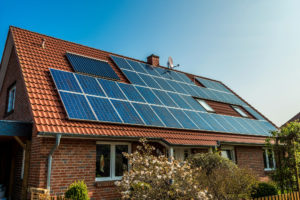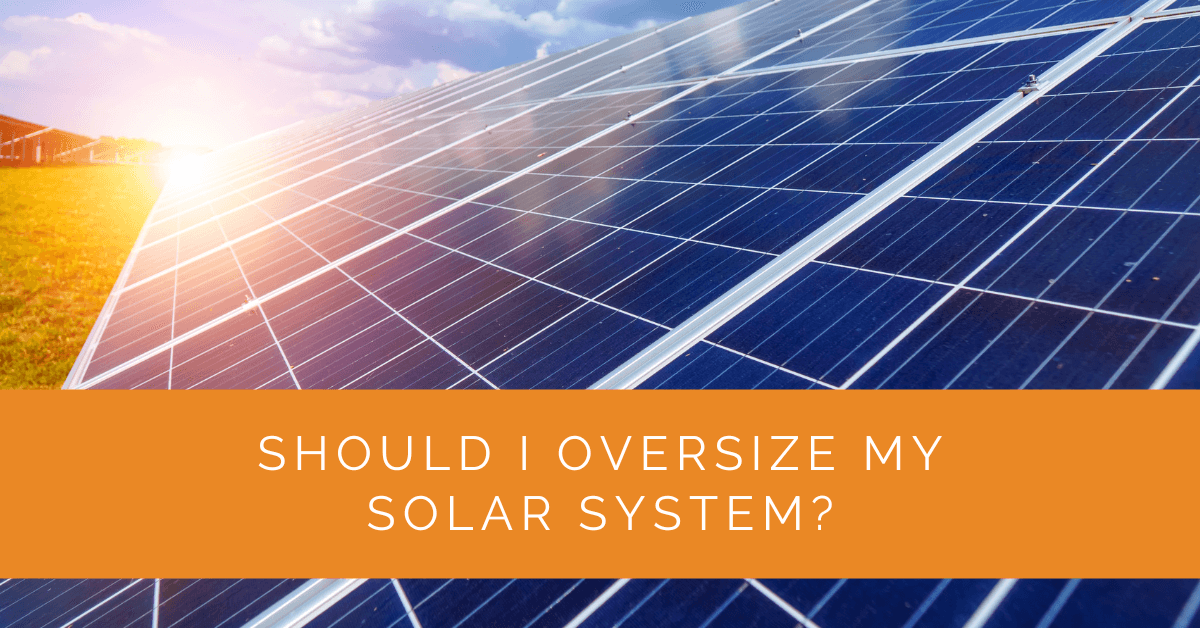When considering a solar panel system, one important question arises: should you oversize your solar system? Oversizing refers to installing a larger system than required to meet your immediate energy needs. In this article, we will delve into the concept of oversizing and explore its benefits, considerations, and how to determine the right size for your solar system.
Contents
- 1 Key Takeaways
- 2 What is Oversizing?
- 3 Factors to Consider
- 4 Benefits of Oversizing
- 5 Drawbacks of Oversizing
- 6 How to Determine the Right Size
- 7 Case Study: The Benefits of Oversizing a Solar System
- 8 Expert Insights From Our Solar Panel Installers About Oversizing Solar Systems
- 9 Experience Solar Excellence with Us!
- 10 Conclusion
- 11 FAQ
Key Takeaways
- Oversizing your solar system can increase energy production, maximize return on investment, and future-proof your system.
- Consider factors such as solar panel performance, inverter capacity, energy consumption patterns, available roof space, and budget before oversizing.
- Consult with a solar professional to determine the right size for your system based on energy analysis, site assessment, and financial projections.
What is Oversizing?
Oversizing involves installing a system with a capacity greater than your immediate energy consumption demands in the context of solar panel systems. This approach allows your solar system to generate surplus energy during peak production. The excess energy can be stored or exported to the grid for later use. By oversizing, you increase the potential power output of your system and maximize its efficiency.
Factors to Consider
Several factors need to be carefully evaluated before deciding to oversize your solar system to ensure optimal results.
Solar Panel Performance
The performance of your solar panels plays a crucial role in oversizing decisions. Factors such as shading, temperature, and degradation can impact the actual energy output of your panels. It is essential to select high-quality panels with optimal performance under varying conditions to maximize the benefits of oversizing.
Inverter Capacity
The inverter is a vital component of a solar panel system as it converts the DC power generated by the solar panels into AC power for use in your home or business. When oversizing, it is crucial to ensure that the inverter can handle the additional power generated by the larger system. Upgrading to a larger inverter may be necessary to accommodate the increased capacity.
Energy Consumption and Usage Patterns
Analyzing your energy consumption patterns is essential to determine the appropriate size of your solar system. Consider current and future energy needs, including any anticipated changes in energy usage. Oversizing your system can provide a buffer for increased energy demands in the future and allow you to become more self-sufficient.
Available Roof Space and Budget
Assessing the available roof space is critical in determining the size of your solar panel system. Oversizing requires additional panel capacity, which may require more roof space for installation. It is also important to consider the budget implications of oversizing, as larger systems typically come with higher upfront costs.

Benefits of Oversizing
Oversizing your solar system can offer several significant advantages:
- Increased Energy Production and Self-Sufficiency: By oversizing, you generate more energy, which can cover a larger portion of your electricity needs. This increased energy production translates into greater self-sufficiency, reducing your reliance on the grid.
- Maximizing Return on Investment: Oversizing allows you to capitalize on the generous solar incentives and net metering programs available in many areas. Your surplus energy can be fed back into the grid, potentially earning credits or monetary compensation.
- Future-Proofing Your Solar System: As energy demands increase, an oversized system ensures you have enough capacity to meet your growing needs. It provides flexibility and adaptability to accommodate lifestyle changes, such as adding electric vehicles or expanding your property.
- Reducing Reliance on the Grid and Cost Savings: Generating more energy from your solar panels means you draw less electricity from the grid, reducing utility bills. Oversizing can help offset or eliminate your electricity costs, providing long-term cost savings.
Drawbacks of Oversizing
While oversizing your solar system offers numerous benefits, it is essential to consider the potential drawbacks:
- Potential Excess Energy Production and Unused Capacity: Oversizing your system may lead to periods of excess energy production, especially during seasons with abundant sunlight. This surplus energy may go unused if you do not have appropriate storage or export options.
- Higher Upfront Costs for Larger Systems: Oversizing requires a larger initial investment due to the increased number of solar panels and potentially a larger inverter. It is important to weigh the upfront costs against the long-term financial benefits.
- Limitations Imposed by Local Regulations and Utility Agreements: Some regions have regulations or utility agreements that restrict the size of solar systems or limit the compensation for excess energy fed back into the grid. Familiarize yourself with the local policies and agreements to ensure compliance.
How to Determine the Right Size
To determine the optimal size for your solar system, it is advisable to consult with a reputable solar professional or installer. They can help you with the following:
- Energy Analysis and Site Assessment: A comprehensive analysis of your energy consumption, site conditions, and available resources can provide insights into the suitable size of your solar system. Factors such as roof orientation, shading, and available space are considered.
- System Performance Estimates and Financial Projections: Solar professionals can provide you with detailed system performance estimates, including projected energy production and potential savings. These estimates help you make an informed decision about the size of your solar system.
Case Study: The Benefits of Oversizing a Solar System
Background
At Solar Panels Network USA, we have helped numerous clients optimize their solar energy systems to meet their energy needs and maximize their return on investment. One such client, a homeowner with increasing energy demands, sought our expertise to upgrade their existing solar panel system.
Project Overview
The homeowner initially installed a modest solar panel system that met their immediate energy needs. However, with plans to add an electric vehicle and potentially expand their home, they were concerned about future energy requirements. We recommended oversizing their solar system to accommodate these anticipated changes.
Implementation
Energy Analysis and Site Assessment
We began with a comprehensive energy analysis and site assessment. This involved evaluating the homeowner’s current energy consumption, potential future energy needs, and the available roof space for additional panels. The site assessment considered factors such as roof orientation, shading, and structural integrity.
Upgraded Component Selection
Based on the analysis, we recommended upgrading the existing system with additional high-efficiency solar panels and a larger inverter to handle the increased capacity. We also suggested incorporating a solar monitoring system to track energy production and consumption in real-time.
Professional Installation
Our team of experienced technicians handled the installation process, ensuring seamless integration of the new components with the existing system. This included removing old panels, installing the new ones, upgrading the inverter, and connecting the monitoring system.
Results
Increased Energy Production and Self-Sufficiency
The upgraded system significantly increased the homeowner’s energy production, covering their current needs and providing a buffer for future energy demands. This resulted in greater energy self-sufficiency and reduced reliance on the grid.
Maximizing Return on Investment
By oversizing the system, the homeowner was able to take advantage of net metering programs, earning credits for surplus energy fed back into the grid. This further offset their energy costs and maximized their return on investment.
Future-Proofing and Flexibility
The oversized system provided the flexibility to accommodate future energy needs, such as charging an electric vehicle and powering additional household appliances. The homeowner felt confident in their energy independence and environmental impact reduction.
Summary
This case study highlights the benefits of oversizing a solar system, including increased energy production, future-proofing for anticipated energy demands, and maximizing return on investment. By conducting a thorough energy analysis and site assessment, selecting appropriate components, and ensuring professional installation, we helped the homeowner achieve their energy goals.
Expert Insights From Our Solar Panel Installers About Oversizing Solar Systems
Oversizing your solar system can provide significant benefits in terms of energy production and future-proofing your energy needs. It’s essential to consider your current and projected energy consumption to ensure the system is designed optimally.
Senior Solar Installer
One of the critical aspects of oversizing is ensuring your inverter can handle the additional capacity. Upgrading to a larger inverter may be necessary to fully utilize the increased energy production from a larger system.
Lead Solar Technician
While oversizing can lead to higher upfront costs, the long-term savings and potential for increased energy independence make it a worthwhile investment for many homeowners.
Solar System Specialist
Experience Solar Excellence with Us!
Trust in Solar Panels Network USA, where our seasoned experts deliver top-quality solar solutions for homes and businesses nationwide. With a legacy of countless successful installations and a commitment to sustainable energy, we’re your reliable partner in the solar journey. Ready for a brighter, eco-friendly future? Call us now at (855) 427-0058 and harness the power of the sun!
Conclusion
When deciding whether to oversize your solar system, it is crucial to consider various factors such as solar panel performance, inverter capacity, energy consumption patterns, available roof space, and budget. You can determine the right size for your solar system by carefully evaluating these factors and seeking professional guidance. Oversizing can increase energy production, greater self-sufficiency, and long-term cost savings. Take the time to explore the possibilities and make an informed decision that aligns with your energy goals and financial circumstances.
Remember, when it comes to solar panel systems, it’s not just about the number of solar panels but rather the overall performance and capacity of the system to produce more power and harness the maximum potential of solar energy.
FAQ
What happens if you oversize a solar system?
Oversizing a solar system means installing a larger system than required to meet your immediate energy needs. The surplus energy generated can be stored or exported to the grid. However, it’s important to ensure that your inverter can handle the excess power and that you have appropriate storage or export options to avoid unused capacity.
Is it better to get a bigger solar system?
Getting a bigger solar system can have advantages, such as increased energy production, higher self-sufficiency, and potentially maximizing your return on investment. However, it’s crucial to consider factors like available roof space, budget constraints, and future energy consumption patterns before deciding on the size of your solar system.
How big should your solar system be?
The size of your solar system depends on various factors, including your energy consumption, available roof space, and budget. Consulting with a solar professional or installer is recommended to conduct an energy analysis and site assessment and provide system performance estimates to determine the optimal size for your solar system.
About the Author
Solar Panels Network USA stands at the forefront of solar energy solutions, driven by a team of seasoned solar engineers and energy consultants. With over decades of experience in delivering high-quality solar installations and maintenance, we are committed to promoting sustainable energy through customer-centric, tailored solutions. Our articles reflect this commitment, crafted collaboratively by experts to provide accurate, up-to-date insights into solar technology, ensuring our readers are well-informed and empowered in their solar energy decisions.

